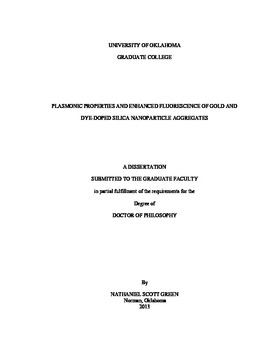| dc.contributor.advisor | Halterman, Ronald L | |
| dc.creator | Green, Nathaniel Scott | |
| dc.date.accessioned | 2019-04-27T21:37:19Z | |
| dc.date.available | 2019-04-27T21:37:19Z | |
| dc.date.issued | 2013 | |
| dc.identifier | 99347837902042 | |
| dc.identifier.uri | https://hdl.handle.net/11244/319182 | |
| dc.description.abstract | The development of metal-enhanced fluorescence has prompted a great interest in augmenting the photophysical properties of fluorescent molecules with noble metal nanostructures. Our research efforts, outlined in this dissertation, focus on augmenting properties of fluorophores by conjugation with gold nanostructures. The project goals are split into two separate efforts; the enhancement in brightness of fluorophores and long distance non-radiative energy transfer between fluorophores. We believe that interacting dye-doped silica nanoparticles with gold nanoparticles can facilitate both of these phenomena. | |
| dc.description.abstract | Our primary research interest is focused on optimizing brightness, as this goal should open a path to studying the second goal of non-radiative energy transfer. The two major challenges to this are constructing suitable nanomaterials and functionalizing them to promote plasmonically active complexes. | |
| dc.description.abstract | The synthesis of dye-doped layered silica nanoparticles allows for control over the discrete location of the dye and a substrate that can be surface functionalized. Controlling the exact location of the dye is important to create a silica spacer, which promotes productive interactions with metal nanostructures. Furthermore, the synthesis of silica nanoparticles allows for various fluorophores to be studied in similar environments (removing solvent and other chemo-sensitive issues). | |
| dc.description.abstract | Functionalizing the surface of silica nanoparticles allows control over the degree of silica and gold nanoparticle aggregation in solution. Heteroaggregation in solution is useful for producing well-aggregated clusters of many gold around a single silica nanoparticle. The dye-doped surface functionalized silica nanoparticles can than be mixed efficiently with gold nanomaterials. | |
| dc.description.abstract | Aggregating multiple gold nanospheres around a single dye-doped silica nanoparticle can dramatically increase the fluorescent brightness of the sample via metal-enhanced fluorescence due to increase plasmonic scattering. Our aim is to promote heteroaggregation with functionalized silica nanoparticles while minimizing homoaggregation of silica-silica or gold-gold species. Reproducible production of multiple gold nanospheres about a dye-doped silica nanoparticle should lead to dramatic fluorescence brightness enhancements in solution. | |
| dc.description.abstract | Gold nanorods can potentially be used to establish radiationless energy transfer between hetero dye-doped silica nanoparticles via gold nanorod plasmon mediated FRET by aggregating two different dye-doped silica nanoparticles preferentially at opposite ends of the nanorod. End-cap binding is accomplished by tuning the strength of gold binding ligands that functionalize the surface of the silica nanoparticles. The gold nanorod can then theoretically serve as a waveguide by employing the longitudinal plasmon as a non-radiative energy transfer agent between the two different fluorophores, giving rise to a new ultrafast signaling paradigm. Heteroaggregation of dye-doped silica nanoparticles and gold nanorods can be potentially employed to as nano waveguides. | |
| dc.description.abstract | Construction and aggregation of functionalized silica and gold nano-materials provides an opportunity to advance the field of fluorescence. The synthesis of gold nano-particles allows control over their size and shape, which give rise to useful optical and electronic properties. Silica nanoparticles provide a framework allowing control over a requisite distance for increasing beneficial and deceasing non-radiative dye-metal interactions as well fluorophore protection. Our aim is to take advantage of fine-tuned synthetic control of functionalized nanomaterials to realize the great potential of solution based metal-enhanced fluorescence for future applications. | |
| dc.format.extent | 250 pages | |
| dc.format.medium | application.pdf | |
| dc.language | en_US | |
| dc.relation.requires | Adobe Acrobat Reader | |
| dc.subject | Fluorescence | |
| dc.subject | Nanoparticles | |
| dc.title | Plasmonic Properties and Enhanced Fluorescence of Gold and Dye-Doped Silica Nanoparticle Aggregates | |
| dc.type | text | |
| dc.type | document | |
| dc.thesis.degree | Ph.D. | |
| ou.group | College of Arts and Sciences::Department of Chemistry and Biochemistry | |
